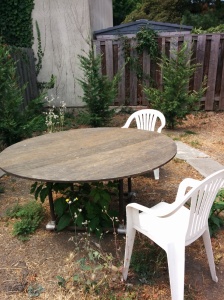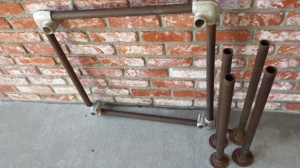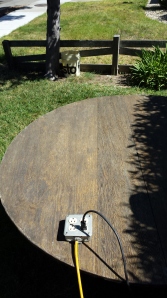I have been noticing, since the fall that injured my brain via a #concussion in early April, that I have had unusual and unique (to me) difficulties with meditation (and life) ever since. Add to this several other “injuries” to my mind and psyche due to: disastrous #heartbreak; a difficult #move cross-country (i.e., getting rid of almost everything, going far away from my spiritual/ meditation teacher and spiritual community/ sangha to relocate to my childhood hometown); long-term, chronic #unemployment; disappointing #ebook sales (due to my having been incapacitated during key #marketing time after my accident); unexpected and painful changes to my #health; turning 60, which have led to my noticing many other problems with my #meditation practice in the last several months that I’ve never had before this (I’ve been meditating since 1972 and doing this practice since 1999).
I think, under these circumstances, which would put me over the top on any stressors test, I am doing quite well. However, I want to meditate, not just do well. Why does my mind keep skittering away from my focus when I try to meditate? What is happening in this brain/mind of mine? I have done many retreats, some as long as eleven weeks, and never had anything like these problems before. My talks with other meditators without brain injuries confirmed that only we injured seem to have these types of difficulties.
But, why? And, what to do about them?
I kept hearing this quote as I continued my attempts:
I pray that this is true….
Since I am a life-long researcher and the internet provides endless opportunities for me to look for “answers,” I looked around for others’ stories, cautionary tales or suggestions. I wanted to find more injured meditators I could commiserate with or teachers who could offer me advice.
What did I find? See below.
Not surprisingly, when I looked for links between “stress” and “meditation,” I found millions of links (17,700,000) referring to the help that meditation provides us when we’re stressed. Meditation for stress reduction, managing stress, alleviating stress, etc., abound on the internet and elsewhere.
NOT ONE article or study to be found that discusses how stress impacts meditation. Really? Really.
Here was my “path”:
“Searches related to meditation problems life stressors” which then provided these other key word strings:
- meditation for stress
- meditation for stress relief
- guided meditation for stress
- meditation for stress and anxiety
- meditation for stress management
- meditation depression
- meditation for stress or sudden shock
- meditation for stress and anger
image from: http://www.paramyogaindia.wordpress.com
I also tried: “Searches related to impact of stress on meditation,” which yielded about 6 million results, but always in the reverse: how meditation helps with stress.
Okay. I must be going about this all wrong. I tried the verbal “OKAY GOOGLE” command and asked: “OKAY GOOGLE: Why am I having trouble meditating?”
I got 1,020,000 results, but these all revolved around problems “beginners” have with “monkey-mind,” or problems many have with setting aside time, being consistent, staying with meditation once they start, etc. I couldn’t look at all one million results, but the associated key word strings confirmed my suspicions: OKAY GOOGLE still did not understand my problem.
Google did offer other choices (some quite hilarious, under the circumstances):
“Searches related to why am I having trouble meditating”:
- i am having trouble pooping
- i am having trouble getting pregnant
- i am having trouble sleeping at night
- i am having trouble breathing
- i am having trouble breathing and my chest hurts
- i am having trouble swallowing
- i am having trouble breathing deeply
- i am having trouble logging into my facebook account
I even tried getting more specific with OKAY GOOGLE, asking: “Why does my concussion make it hard for me to meditate?” This query led me to even stranger associations than before, including recommendations for those with concussions to meditate to help heal from their concussions.
Huh?
I don’t know whether to be flattered or to cry when this also had my own article from my blog post in May as the number 3 listing among 11,000,000 results: concussion | Sally Ember, Ed.D. sallyember.com/tag/concussion/ May 2, 2014
If I’m one of the “experts,” here, we’re all in trouble.
image from http:///funny-pictures.picphotos.net
So, I was going to give up on finding “help” but then I tried this search string: “research meditation frontal lobe injuries” and hit the jackpot.
First, this quote (unattributed) kept appearing: “Meditation is a frontal lobe activity,” which affected me deeply. My accident, for those who don’t know, involved my hitting a wall face-first, breaking my nose and impacting my forehead, behind which is the frontal lobe.
Here are some selected quotes from the best article I found, from the UK, that clarifies a lot about the functions of the frontal lobe, its effects on and participation in the activity of meditation, and many other aspects of my experience: very illuminating and helpful.
Case study on function of the frontal lobe
“The frontal lobes play a major role in the regulation of our emotions and behaviour as well as planning, decision making, social conduct, and executive functions. They are vulnerable to damage… [and] are thought to be our emotional control centre [sic; UK spelling] and home to our personality.”
“The frontal lobes are vulnerable to injury and damage due to their location at the front of the skull and their ample size. Magnetic Resonance Imaging studies have revealed that the frontal area is the most frequent region of damage following brain injury (Levin et al., 1987). Statistics show that there is no other component of the brain in which impairment can cause such a wide array of symptoms (Kolb and Wishaw, 1990).”
This began to intrigue me, especially the part about the “wide array of symptoms,” which I can attest to experiencing. Some of my “symptoms” have seemed to be unclearly connected to the concussion until I read more of this article.
“The frontal lobes are involved in problem solving, spontaneity, memory, language, initiation, judgement [sic; UK spelling], impulse control, social cognition (Benson, 1996) and sexual behaviour. Motor function is also seen to be controlled by the frontal lobes (Leonard et al., 1988).”
I have noticed my balance is off, my proprioceptors are off, my sense of security on my feet is reduced, but until I read this, I wasn’t sure if I was suffering from a bit of PTSD and wariness about falling again or actually having trouble. The latter, I believe now, is the case.
“Broca’s Aphasia has also been linked with frontal lobe damage (Brown, 1972). It is supported that frontal lobe damage has an effect on memory and attention (Stuss et al., 1985).”
Ding ding ding: points for all. Unfortunately.
“Mesulam (1986) pointed out from his studies, that some people who have suffered frontal lobe damage show impairments in their everyday life; however they show little or no impairment on clinical neurological assessment tests….[One injured patient was] unable to make decisions and plan…often unable to make simple everyday decisions, such as which toothpaste to buy, what restaurant to go to, or what to wear even after endless comparisons and contrasts Damasio (1985)….This may be characterised as a failure of future memory, the ability to encode delayed intentions, and act on those intentions when the appropriate time arrives.”
Usually I am extremely decisive. Even when there are complex factors, even when I feel ambivalence: before this accident and its injuries to my brain, I was considered a person others could rely on to make the choices they could or would not make. Since then, I have had hesitation, confusion, bewilderment, inability to weigh costs and benefits and many other unusual reactions to being asked to choose even the simplest things. Now I know the reasons for this befuddlement. Good.
“Interestingly, some patients who suffer from frontal lobe damage often do not show any defects on neuropsychological tests. However, when observed in unstructured real world settings, patients frequently demonstrate cognitive difficulties, neurobehavioral symptoms, and deficits in their executive functions.”
I would say, without a doubt, that the most severe deficit to my executive functions has been first my complete inability and then my reduced ability to meditate, since meditation has become the foundation for all the thinking, choosing and behaving in my life via values, personality and habit changes.
image from: http://www.brainline.org
I can see ways I’ve regressed since the accident and these are disturbing in deep and superficial ways. I’m more impatient, more quick to anger, easily provoked to sadness or hurt. I hide it from those close to me but take it out on customer service representatives of mega-corporations which happen to provide terrible service. Not proud of this at all.
“Studies have found high frontal lobe activation during meditation (Herzog et al, 1990; Lazer et al, 2000).”
IF I COULD MEDITATE, I would, also. I miss meditating so much. But, now I know a bit more about the reasons for my difficulties.
I hope this post and the rest of this article (link, below) help others in similar predicaments.
Keep trying, keep going: got to believe it will improve.
I’m also going to see if I can talk (or video chat) with my meditation teacher some time soon. I need something.
A quote from Thich Nhat Hanh is what I plan to contemplate until my meditation practice gets back on track.











You must be logged in to post a comment.